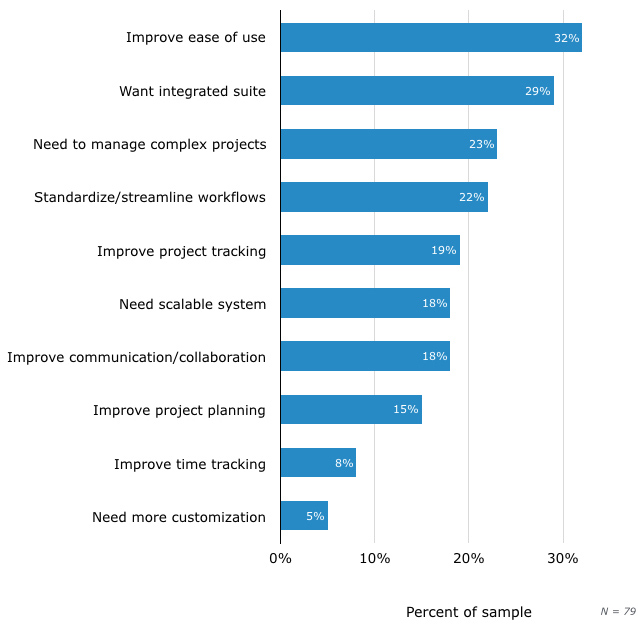That’s the key finding of a recent report released by research and reviews firm Software Advice. The company receives hundreds of project management software consultation requests annually. It has selected for this study a random sample of recent consultations to learn more about SMB buyers searching for cloud-based PM solutions. In this context, PM software acquisition remains a top business priority.
Important Findings
- Most SMB buyers (60%) are looking to purchase PM software for the first time, a trend that has remained the same since 2014.
- The two most-requested software tools are task management (70%) and reporting (49%) — a split between basic and advanced functionality.
- First-time buyers cite the need to automate processes (30%) as their main purchase driver, while most repeat buyers want to improve ease of use (32%).
The majority of Prospective Buyers Aren’t Using PM Software
Just one-third of the buyers in this year’s sample (35% combined) currently use project management software to manage their projects. On the other hand, a combined 60% are still using manual methods (pen and paper, email, or spreadsheets), non-PM software (Microsoft Office or Google Apps), or nothing at all.

Prospective buyers’ current methods
The rough one-third/two-third split between buyers replacing software and purchasing it for the first time is a consistent trend across the annual PM buyer reports:
In 2014, 35% were looking to replace their existing system, versus a combined 61% who were using manual methods and/or non-PM software.
In 2015, 32% used PM software, while 70% of the buyers sampled used manual methods.
This indicates that first-time buyers remain the largest demographic in the PM marketplace, as SMBs continue to find manual methods and non-specialized software insufficient for managing projects.
Cory Chaplin, the director of the Technology Integration practice at West Monroe Partners, says businesses often use Microsoft Excel to manage projects when the complexity and number of projects are low, eventually making the jump to PM software as both increase.
What’s more, Chaplin notes, the shift to specialized software can be triggered by the team’s growth. Managers of larger teams must manage resources more effectively—especially when teams are geographically distributed.
Kurt Schmidt, the director of project management at The Nerdery, notes that as teams grow and advance in PM maturity, they require software that provides the necessary structure to scale management processes across an organization.
Buyers Request PM Platforms With Well-Rounded Functionality
Top-requested PM software functionality
Task management is considered a basic software capability because it deals with the day-to-day management of work items. The same is true for time tracking, which allows managers to assign tasks for the immediate future and measure the time it takes to complete them.
In addition to timekeeping, invoicing software with late fees and such features are best for small and medium-sized businesses in comparison to enterprises, which could afford pricier accounting services. If you need a quick way to create an invoice based on your hourly work, opt for an invoice generator for your small business to thrive.
As teams mature in their PM methods, they require more advanced functionality that allows them to forecast farther into the future.
Automation and Standardization top priority for PM software acquisition
The top purchase drivers for first-time buyers include the needs to:
- Automate processes and reduce errors (30%)
- Standardize processes and workflows (26%)
- Increase visibility and accountability among team members (23%)
Top reasons for evaluating PM software for the first time
These pain points are not uncommon for first-time buyers — especially for those using manual methods. For example, many businesses that start using spreadsheets eventually run into version-control issues or errors due to manual data entry.
Manually managing everything in Excel is virtually impossible, because [users] can’t be simultaneously logged on and making data changes. – ANONYMOUS FIRST-TIME PM SOFTWARE BUYER
Excel can’t manage any actual deliverables or tasks. Employees have to manually email out project schedule updates, which is incredibly time-consuming. – ANONYMOUS FIRST-TIME PM SOFTWARE BUYER
These issues can further compound when processes and workflows aren’t standardized across a group. For example, if different teams update task status notes at different times of day, it can be challenging for managers to gauge project progress accurately.
Plus, imagine having to keep track of every metric on a daily basis, updating internal costs and billable hours manually. Measuring these with the help of a project management tool is a breeze—read here how to calculate project profitability.
Cloud-based PM systems can help solve these business problems by automating daily task management, resource management, and scheduling.
Cloud systems automatically update in real-time as progress on tasks and changes are made to a project schedule. Even better, the platform itself serves as a standardized, structured work environment for users.
NOTE: If you’re looking for a professional resource distribution tool for your team, check out this top resource management software.
Improve Ease of Use Is Top Driver for Replacing Software
Top reasons for replacing software
The findings reflect the fact that purchasing software is typically the easy part. Implementing the system and training employees to use it are areas where businesses tend to run into problems, or if end users don’t find the new software user-friendly enough, they won’t use it.
One way to combat this issue is to test and trial potential products. Most vendors offer product demos or free trial periods where businesses can vet products before they buy.
Conclusions
Based on the results of this research, prospective buyers of cloud-based PM software should evaluate their organization’s PM maturity and plans for growth before investing in new solutions.
This will help buyers assess their needs in the coming years and whether they’ll require software with more advanced functionality to support them.
Note: if you’re wondering what are the project manager requirements in tech and its roadmap, read up on our educational guide.
First published on March 24, 2016.

Laurențiu Bancu
Author
Laurențiu started his marketing journey over 18 years ago and now leads a marketing team. He has extensive experience in work and project management, and content strategy. When not working, he’s probably playing board games or binge-watching mini-series.




